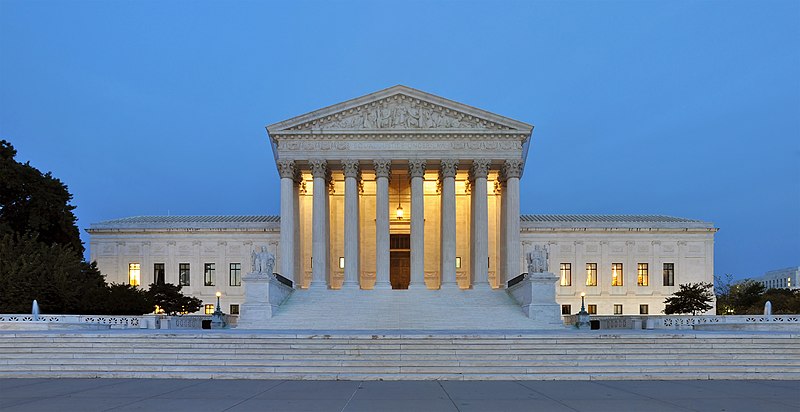7.1 Chapter Overview and Learning Objectives
In this chapter, we’ll explore the structure and role of courts in the American criminal justice system, emphasizing the concept of jurisdiction. Courts, often housed in courthouses, play a vital role in solving legal disputes and making critical decisions, including those with life-and-death consequences. Understanding court traditions, roles, and practices is essential for grasping the fundamentals of the justice system. After completing this chapter, you’ll understand how a criminal case progresses from the initial filing of charges in a local courthouse to the final stage of the appeals process, which for only a handful of cases will end in the U.S. Supreme Court building pictured in figure 7.1.

This chapter also examines the selection, roles, and responsibilities of the participants in the criminal courts, frequently referred to as the courtroom workgroup. You will become familiar with the players during each step of the process. While courts aim to be fair, they’re not flawless. This is particularly evident in their treatment of women, low-income individuals, and marginalized racial groups, whether as suspects or defendants. The American justice system, including its courts, has struggled with diversity, equity, and inclusion (DEI) issues throughout its history.
Learning Objectives
After reading this chapter, students will be able to:
- Describe the progression of a crime or criminal case from the trial court level to the U.S. Supreme Court. Students should understand the hierarchy of both federal and state courts.
- Differentiate between various types of jurisdiction and understand how these jurisdictional rules apply to different cases based on factors such as the seriousness of the offense, the location of the crime, and the authority of the court.
- Identify and describe the roles and interactions of key members within the courtroom work group, including judges, prosecutors, defense attorneys, and other courtroom personnel. Students should understand how the dynamics of the courtroom work group influence case outcomes and the administration of justice.
- Explain the process of appeals in the legal system, including how parties petition the appeals court for case review, and understand the decision-making process employed by appellate courts.
Key Terms
Below are some of the most important key terms and phrases used in this chapter. You should review and become familiar with these terms before reading this chapter:
- Appellant (petitioner)
- Appellate courts
- Appellee (respondent)
- Bench trial
- Court of last resort
- Court-appointed attorney
- Courtroom workgroup
- Courts of general jurisdiction
- Courts of limited jurisdiction
- Defense lawyers
- Dual court system
- Jurisdiction
- Jury trial
- Interlocutory appeal
- Original jurisdiction
- Principle of orality
- Prosecutor
- U.S. Court of Appeals
- U.S. District Courts
- U.S. Supreme Court
- Writ of certiorari (rule of four)
- Writs of habeas corpus
Critical Thinking Questions
Take a few minutes and reflect on these questions before you read the chapter to assess what you already know. Then, after reading the chapter, return to these questions to gauge how much you’ve learned:
- Knowing what happens at trial and what happens on appeal, would you be more interested in being a trial judge or an appellate judge? Why?
- Why is there a different standard of review for questions of fact and questions of law?
- Do you agree that cases should be overturned only when a fundamental or prejudicial error occurred during the trial?
- Do you think it is easier to be a defense attorney than a prosecutor, believing the defendant is guilty but knowing that the justice system has violated the defendant’s rights?
- Should the defendant ever waive the assistance of counsel?
- Does any position as a court staff particularly interest you? Why or why not?
Licenses and Attributions for Chapter Overview and Learning Objectives
Open Content, Shared Previously
“Chapter Overview” is adapted from “7.1. Introduction to the U.S. Court System” by Lore Rutz-Burri in SOU-CCJ230 Introduction to the American Criminal Justice System by Alison S. Burke, David Carter, Brian Fedorek, Tiffany Morey, Lore Rutz-Burri, and Shanell Sanchez, licensed under CC BY-NC-SA 4.0. Modifications by Sam Arungwa, revisions by Roxie Supplee, licensed CC BY-NC-SA 4.0, including rewriting the learning objectives and introduction, and modifying the key terms list.
Figure 7.1. “Panorama of United States Supreme Court Building at Dusk” by Joe Ravi, Wikimedia Commons is licensed under CC BY-SA 3.0.
The criminal justice system is a major social institution that is tasked with controlling crime in various ways. It includes police, courts, and the correction system.
The authority of a court to hear and decide a case.
The highest court in the United States, with the authority to review decisions of all lower federal courts and state courts.
The collaborative relationship between judges, prosecutors, and defense attorneys who work together to move cases through the court system.
Courts that review decisions made by trial courts.
A system of rules enforced through social institutions to govern behavior.
A government attorney who represents the state in criminal cases and is responsible for bringing charges against defendants and arguing for their conviction.

